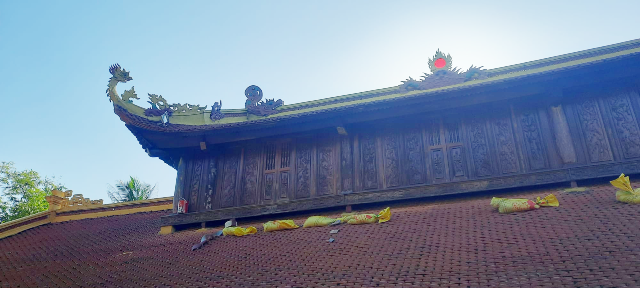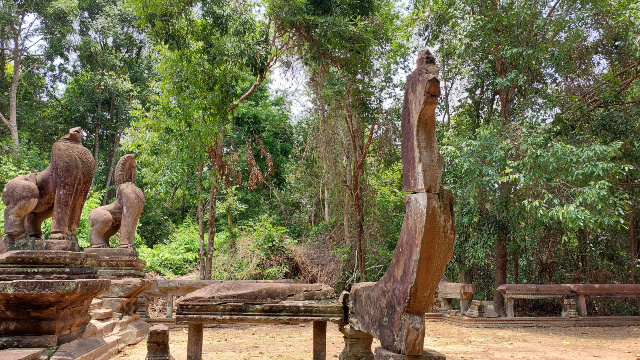Tran Quoc Pagoda or Chùa Trấn Quốc in Vietnamese is located on the east side of Hanoi's west lake. It is one of most ancient pagodas dating back to more than 1, 500 years. The Mahayana Buddhist pagoda, was the center during the Ly and Tran dynasties.
stupa seen from a distance
bridge for American War Memorial, which cuts across the lake connecting to pagoda
History of Pagoda:
- The pagoda is said to start its construction in 541 and was completed in 545 under the reign of King Ly Nam De, who was the founder of early Ly dynasty in Vietnam.
- It was initially located beside Red River and was known as Khai Quoc.
- In 1615, during Le Trung Hung, it was moved to Yen Phu dyke.
- During 1624, 1628 and 1639, it continued to be expanded and restored.
- Due to erosion on the river bank, the pagoda was again moved during the reign of King Le Hy Tong(1600-1618) and renamed Tranc Quoc.
- Last restoration was in 2010 to celebrate the 1000th anniversary of Hanoi.
birds to be released for making merit
fish considered to bring good luck ready to go back in lake
Bodhi tree at entrance
entrance gate of pagoda
Dragons facing each other at the entrance gate
We did not check the pagoda timings and not until we reached the pagoda, did we come to know that it would be closed for lunch. We instead of waiting decided to go to One Pillar Pagoda
Bao Thap Luc Do Dai Sen:
Built in 1998, no one can miss seeing the 11 storey tower, Bao Thap Luc Do Dai Sen or the precious stupa. The tower is 15 meters tall.
The six sided tower has an image of Amitabha Buddha in each niche.
It is built symmetrically opposite to Bodhi tree,which is in front of the Tien Duong or the front house or the back side from where we stand now.
On top of the pagoda, is a nine-storey lotus called Cuu Pham Lien Hoa made of precious stones.
tombs from 18th century
Ancient tombs from 18th century during the Vinh Huu and Canh dynasties
image of Amitabha Buddha
All images are made in white stone and are in dhyaan mudra or the meditative posture. Lord Buddha sits on a fully bloomed lotus signifying the end of journey.
He has a swastika on his chest symbolizing the seat of Buddha's heart. Swastika should not be confused with the Nazi symbol.
The central pillar is surrounded by two and three tiered pillars.
All pillars have Buddhist "Aum" symbol
inside each pillar is a container for burning joss sticks
each pillar is topped with a lotus, some of them
offerings
The complex has three main houses: Tien Duong, Thuong Dien and Nha Thieua.
The upper hall, Thuong Dien is connected to Tien Duong or the front house.
upper hall
dragon at the side of roof
There are lot of valuable statues of worship in the upper room. One most notable image is that of Shakyamuni entering Nirvana, that is the reclining pose which is very common to see in the wats of Thailand but here in Vietnam, it is not very common. Called by the locals as "Thich Ca Thap Niet Ban".
Unfortunately, it was closed when we visited the place.
house of stele
stone stele
The stele has record of pagoda's history.
pictorial illustration of Law of Karma
Nha To, place to worship gods and goddesses
In front is the incence burning urn.
Shrine of Mothers
Some of the oldest goddesses are worshiped here. In green dress, is the mother of mountains and forests, in red is the Mother of sky and the white Mother represents water.three sages and ancestor monks of pagoda
This is very typical of a Chinese temple, where they burn the fake notes and votives
west facing Tien Duong or the front house
Inside the front house, an altar has many precious Buddha images
images inside the temple
Opposite the front house is a huge Bodhi tree. It was a gift to Ho Chi Minh when Dr. Rajendra Prasad, the then President of India visited Hanoi in 1959.
devotees circumambulating the tree
Though, not a very big pagoda, it is a must see in Hanoi.
Timings:
0730 - 1130
1330 - 1730
entrance : free




































































